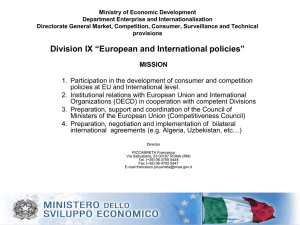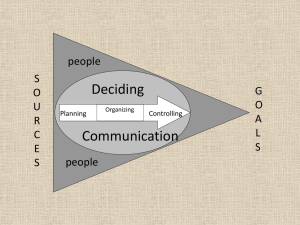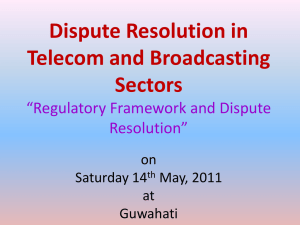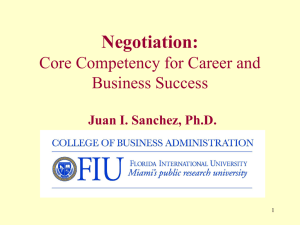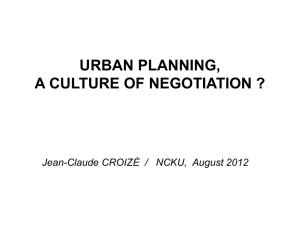Microsoft Word - 254SyllabusSpring2005.doc
advertisement
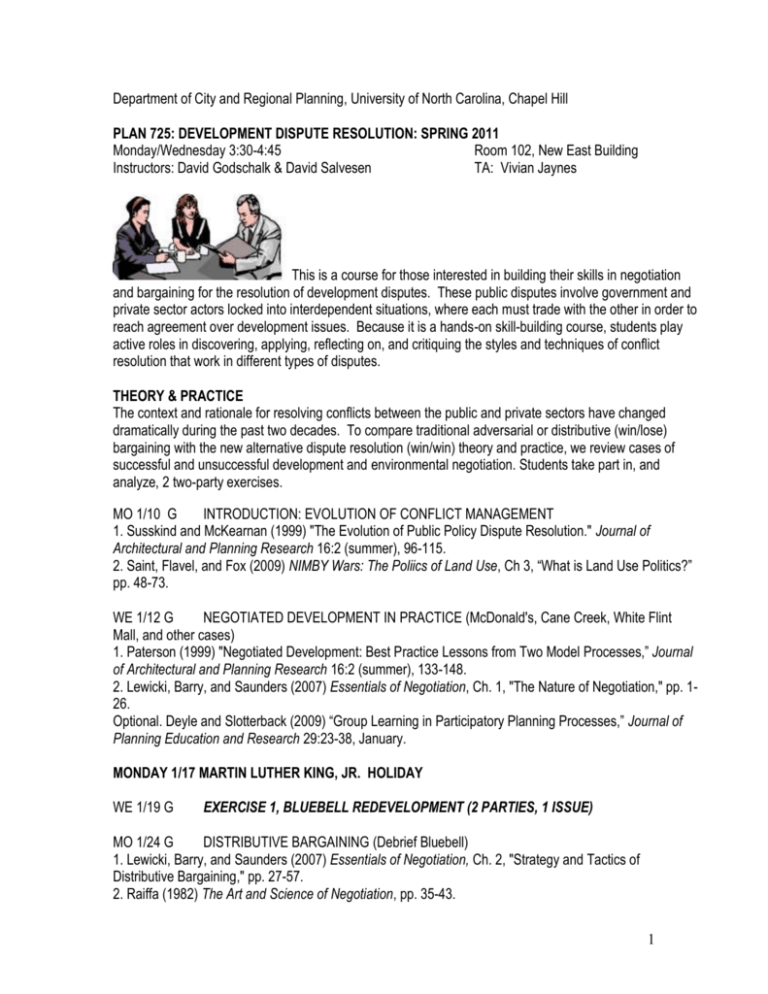
Department of City and Regional Planning, University of North Carolina, Chapel Hill PLAN 725: DEVELOPMENT DISPUTE RESOLUTION: SPRING 2011 Monday/Wednesday 3:30-4:45 Room 102, New East Building Instructors: David Godschalk & David Salvesen TA: Vivian Jaynes This is a course for those interested in building their skills in negotiation and bargaining for the resolution of development disputes. These public disputes involve government and private sector actors locked into interdependent situations, where each must trade with the other in order to reach agreement over development issues. Because it is a hands-on skill-building course, students play active roles in discovering, applying, reflecting on, and critiquing the styles and techniques of conflict resolution that work in different types of disputes. THEORY & PRACTICE The context and rationale for resolving conflicts between the public and private sectors have changed dramatically during the past two decades. To compare traditional adversarial or distributive (win/lose) bargaining with the new alternative dispute resolution (win/win) theory and practice, we review cases of successful and unsuccessful development and environmental negotiation. Students take part in, and analyze, 2 two-party exercises. MO 1/10 G INTRODUCTION: EVOLUTION OF CONFLICT MANAGEMENT 1. Susskind and McKearnan (1999) "The Evolution of Public Policy Dispute Resolution." Journal of Architectural and Planning Research 16:2 (summer), 96-115. 2. Saint, Flavel, and Fox (2009) NIMBY Wars: The Poliics of Land Use, Ch 3, “What is Land Use Politics?” pp. 48-73. WE 1/12 G NEGOTIATED DEVELOPMENT IN PRACTICE (McDonald's, Cane Creek, White Flint Mall, and other cases) 1. Paterson (1999) "Negotiated Development: Best Practice Lessons from Two Model Processes,” Journal of Architectural and Planning Research 16:2 (summer), 133-148. 2. Lewicki, Barry, and Saunders (2007) Essentials of Negotiation, Ch. 1, "The Nature of Negotiation," pp. 126. Optional. Deyle and Slotterback (2009) “Group Learning in Participatory Planning Processes,” Journal of Planning Education and Research 29:23-38, January. MONDAY 1/17 MARTIN LUTHER KING, JR. HOLIDAY WE 1/19 G EXERCISE 1, BLUEBELL REDEVELOPMENT (2 PARTIES, 1 ISSUE) MO 1/24 G DISTRIBUTIVE BARGAINING (Debrief Bluebell) 1. Lewicki, Barry, and Saunders (2007) Essentials of Negotiation, Ch. 2, "Strategy and Tactics of Distributive Bargaining," pp. 27-57. 2. Raiffa (1982) The Art and Science of Negotiation, pp. 35-43. 1 WE 1/26 G CONFLICT STYLES AND ETHICS (Conflict style survey) 1. Lewicki, Barry, and Saunders (2007) Essentials of Negotiation, Dual Concerns Model, pp. 21-23; Ch. 8, "Ethics in Negotiation," pp. 167-189. MO 1/31 G FRAMING AND REFRAMING 1. Kaufman and Smith (1999) “Framing and Reframing in Land Use Conflicts,” Journal of Architectural and Planning Research 16:2 (summer), 164-180. 2. Faga (2006) “Youngstown’s New Vision,” Designing Public Consensus: The Civic Theater of Community Participation for Architects, Landscape Architects, Planners, and Urban Designers, pp. 53-82. WE 2/2 G EXERCISE 2, MAP EXERCISE (2 PARTIES, 1 ISSUE) MO 2/7 G GETTING TO YES (Debrief MAP exercise) 1. Fisher, Ury & Patton (1991) Getting to Yes: Negotiating Agreement without Giving In, Ch.1-5, pp. 1-94. (Skim rest) STRATEGY & TACTICS Negotiation process dynamics make the difference between win/lose and win/win outcomes. After analyzing their present ways of dealing with conflict, students are introduced to different types of negotiation strategies and tactics. They learn the principles of integrative (principled) negotiation, techniques of stakeholder analysis, use of efficiency frontiers for assessing outcomes, and methods of information exchange. They test these approaches in 2 exercises of increasing complexity. WE 2/9 G INTEGRATIVE NEGOTIATION 1. Godschalk (1992) “Negotiating Intergovernmental Development Policy Conflicts: Practice-Based Guidelines,” APA Journal, Summer, pp. 368-378. (Rural Buffer case) 2. Lewicki, Barry, and Saunders (2007) Essentials of Negotiation, Ch 3, "Negotiation: Strategy and Tactics of Integrative Negotiation," pp. 58-84. MO 2/14 G MULTIPLE PARTY NEGOTIATION/STAKEHOLDER ANALYSIS (Snow cards) 1. Lewicki, Barry, and Saunders (2007) Essentials of Negotiation, Ch. 10, "Multiple Parties and Teams," pp. 208-228. 2. Levitt & Kirlin, eds. (1985) Managing Development Through Public/Private Negotiations, Ch. 6, pp. 4962. 3. Bryson and Crosby (1992) Leadership for the Common Good, pp. 141-145, 363-367. WE 2/16 G EXERCISE 3, FARMLAND CONVERSION (3 PARTIES, 1 ISSUE) MO 2/21 S NEGOTIATION POWER (Debrief Farmland Conversion 1. Lewicki, Barry, and Saunders (2007) Essentials of Negotiation, Ch. 7, "Finding and Using Negotiation Power," pp. 149-166; Ch 12, “Best Practices in Negotiation,” pp. 256-264. WE 2/23 S MAINTAINING RELATIONSHIPS 1. Lewicki, Saunders, Barry, and Minton (2004) Essentials of Negotiation, Ch 9, “Relationships in Negotiation,” pp. 190-207. 2. Susskind, Levy, and Thomas-Larmer (2000) Part 1, “The Mutual Gains Approach,” in Negotiating 2 Environmental Agreements, pp. 17-40. MO 2/28 G NEGOTIATION STRATEGY AND PLANNING (Personal profile discussion) 1. Howe (2002) "Smart, or Not So Smart: Large-scale, Mixed-use Infill Fails the IQ Test in Raleigh," Planners Casebook, No. 40, Spring, pp. 1-8. (Coker Dispute facilitation) 2. Lewicki, Barry, and Saunders (2007) Essentials of Negotiation, Ch 4, “Negotiation: Strategy and Planning,” pp. 85-110. WE 3/2 G EXERCISE 4, EPA V RIVERSIDE (2 PARTIES, MULTIPLE ISSUES) (Turn in term paper topic and outline.) SPRING BREAK 3/4-3/113 MO 3/14 G PURSUING THE EFFICIENT FRONTIER (Debrief EPA/Riverside) 1. Raiffa, The Art and Science of Negotiation. Ch. 10, pp. 131-147. ASSISTED NEGOTIATION The role of the neutral third party is introduced in this part of the course. Single text creation, computerassisted negotiation, and dispute resolution system design are explored. Students take part in 2 assisted negotiation exercises involving difficult issues of community value conflicts. WE 3/16 S FACILITATION IN PRACTICE: Andy Sachs, Guest Speaker 1. Kaner (2007) Facilitator's Guide to Participatory Decision-Making. Second edition. Ch. 3, “Introduction to the Role of Facilitator,” and Ch. 4, “Facilitative Listening Skills,” pp. 31-60. MO 3/21 S CONSENSUS BUILDING (Single Text) 1. Raiffa The Art and Science of Negotiation. Ch. 14, 205-217. (Camp David). 2. Innes and Booher (1999) “Consensus Building and Complex Adaptive Systems,” APA Journal, 65:4, pp. 412-423. Autumn. Optional. Straus (1999) “Managing Meetings to Build Consensus,” Ch. 7 in The Consensus Building Handbook, Susskind, McKearnan, and Thomas-Larmer, eds, pp.287-323 WE 3/23 S EXERCISE 5, CLIMATE CHANGE ADAPTATION: FLOODING 1. Global Climate Change Impacts in the U.S. (2009) pp. 27-40. MO 3/28 S PLANNING ROLES IN CONFLICT MANAGEMENT (Debrief Climate Change Adaptation) ) 1. Forester (1987) "Planning in the Face of Conflict: Negotiation and Mediation Strategies in Local Land Use Regulation," APA Journal 53:3, pp. 303-314. 2. Sirianni (2007) “Neighborhood Planning as Collaborative Democratic Design: The Case of Seattle,” APA Journal 73 (4), Autumn, pp. 373-387. WE 3/30 S UNC/CHAPEL HILL DEVELOPMENT AGREEMENT. David Owens, Guest Speaker 1. Lewicki, Barry, and Saunders (2007) Essentials of Negotiation, Ch 5, Perception, Cognition, and Emotion," pp. 111-134; and Ch 6 “Communication,” pp. 135-148. 2. Carolina North Development Agreement. http://www.ci.chapel-hill.nc.us/index.aspx?page=1232 MO 4/4 S MEDIATION 3 1. Moore (1996) The Mediation Process: Practical Strategies for Resolving Conflict. Ch. 2, pp.41-77, and caucuses, pp. 319-326. 2. Oregon Dept. of Land Conservation and Development (1996) Ch. 6, pp. 45-67. 3. Smith (1998) “The Catron County Citizens Group: A Case Study in Community Collaboration,” Ch. 13 in The Consensus Building Handbook, Susskind, McKearnan, and Thomas-Larmer, eds,pp. 985-1009. 4. Video. The Visionaries. Catron County case. WE 4/6 S EXERCISE 6, ROCKVILLE ((MULTI-PARTIES & ISSUES, MEDIATED) 1. Susskind, van der Wansem, and Ciccarelli (2000) Meditating Land Use Disputes: Pros and Cons. Lincoln Institute of Land Policy, pp. 1-40. MO 4/11 S INTERNATIONAL NEGOTIATION (Debrief Rockville ) APA Conference April 10-12, 2011 1. Lewicki, Saunders, Barry, and Minton (2004) Essentials of Negotiation, Ch 11, “International and CrossCultural Negotiation,” pp. 229-255. WE 4/13 S DESIGNING PUBLIC CONSENSUS: COMMUNITY BENEFIT AGREEMENTS (In class review and critique of community benefits negotiation) 1.Wolf-Powers (2010) “Community Benefits Agreements and Local Government,” Journal of the American Planning Association 70:2, Spring, pp. 141-159. 2. Faga (2006) Ch 2, “Ground Zero,” and ‘Afterword,” Designing Public Consensus: The Civic Theater of Community Participation for Architects, Landscape Architects, Planners, and Urban Designers, pp. 23-39, and 201-208. 3. Susskind (2010) “Overcoming the Not-In-My-Backyard (NIMBY) Syndrome” http://the consensusbuildingapproach.blogspot.com/2010/08. Pp. 1-7. MO 4/18 S FUTURE PUBLIC DISPUTE RESOLUTION 1. Shmueli, Kaufman, and Ozawa (2008) “Mining Negotiation Theory for Planning Insights,” Journal of Planning Education and Research 27, pp. 359-364. 2. Saint, Flavel, and Fox (2009) NIMBY Wars: The Politics of Land Use, Ch 10, “The Future of Land Use Politics,” pp. 262-284. DEVELOPMENT DISPUTE CASES Students present their analyses of development disputes, including descriptions of the issues, stakeholders, and outcomes, as well as recommendations for more effective dispute resolution. These analyses are based on primary data drawn from interviews, observations, and other sources. WE 4/20 STUDENT CASE PRESENTATIONS MO 4/25 STUDENT CASE PRESENTATIONS WE 4/27 STUDENT CASE PRESENTATIONS Term papers due. ) COURSE REQUIREMENTS Each student will be required to: 1. Participate in six negotiation exercises, including writing a brief (2 page) individual post-exercise 4 evaluation. Grades will be assigned based on both exercise performance and demonstration in the written evaluation of combined learning from the negotiation and the readings. (72% of total grade) Evaluations are due in the class following the exercise. Grades will be reduced for evaluations turned in late. 2. Prepare a term paper describing and analyzing a development dispute, and present your findings in class at the end of the semester. Include a chronology of actions, a stakeholder analysis, and your recommendations for an improved outcome. Team papers are encouraged. (23% of total grade) Topic and outline due on March 2, prior to spring break. Final paper due on last day of class. 3. Participate actively in class activities, including review and critique of an assigned case. Complete assigned readings, attend class sessions (since this course relies on in-class exercises to a great extent, regular attendance is critical, and any absences must be cleared with instructor in advance), and actively discuss and critique the readings in the context of class discussions. At a minimum, students are expected to be able to discuss assigned readings; optimally, students should be able to relate ideas from readings to experience, practice, and broader theories. (5% of total grade) READINGS Two texts are recommended. Both are available for purchase at Student Store. Lewicki, Roy J., Bruce Barry, and David M. Saunders (2007) Essentials of Negotiation. Irwin McGraw-Hill. Fourth Edition. Paperback Fisher, Roger, and William Ury. (1991) Getting to Yes: Negotiating Agreement Without Giving In. 2nd edition. Penguin Books. Paperback. All readings, with the exceptions of the two texts, are on posted on Blackboard. SUPPLEMENTAL RESOURCES Web sites on conflict resolution: Association for Conflict Resolution (ACR) www.acrnet.org Community Building Institute www.communitytools.net Consensus Building Institute www.cbi-web.org International Association of Facilitators www.iaf-world.org International Association for Public Practitioners www.iap2.org National Association for Community Mediation (NAFCM) www.nafcm.org National Civic League www.nci.org Policy Consensus Initiative www.policyconsensus.org State Offices and Programs: California Center for Public Dispute Resolution www.csus.edu/ccpdr Florida Conflict Resolution Consortium http://consensus.fsu.edu Georgia Consortium on Negotiation and Conflict Resolution http://law.gsu.edu/CNCR Hawaii Matsunga Institute for Peace http://ww2.soc.hawaii.edu/peace Indiana Conflict Resolution Institute www.spea.indiana.edu/icri Maryland Mediation and Conflict Resolution Office www.courts.state.md.us/adr.html Massachusetts Office of Dispute Resolution www.state.state.ma.us/modr Michigan Community Dispute Resolution Program www.courts.michigan.gov/scao/dispute Montana Consensus Council www.discoveringmontana.org Nebraska Justice Center www.connectfremont.org/COMSER/mediation.htm North Carolina Mediation Network www.mnnc.org North Dakota Consensus Council www.agree.org Ohio Commission on Dispute Resolution and Conflict Management www.state.oh.us/cdr Oregon Public Policy Dispute Resolution Program www.odrc.state.or.us/ppdrp.htm Texas Center for Public Policy Dispute Resolution www.tnrcc.state.tx.us Virginia Environmental Institute for Negotiation www.virginia.edu Federal Offices and Programs: Interagency ADR Working Group www.usdoj.gov/adr 5 US Institute for Environmental Conflict Resolution www.ecr.gov US EPA Public Involvement www.epa.gov/publicinvolvement Newsletters and journals dealing with dispute resolution: Consensus; Dispute Resolution Forum; International Journal of Conflict Management; Journal of Conflict Resolution; Journal of Dispute Resolution; Mediation Quarterly; Negotiation Journal; Resolve; The Justice System Journal CONTACTS Dave Godschalk: dgod@email.unc.edu. David Salvesen: dsalv@email.unc.edu. 6


